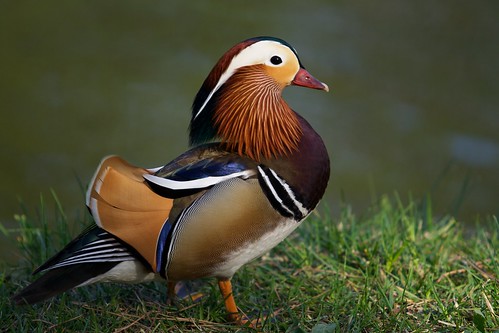The Mandarin Duck (Aix galericulata), or just Mandarin, is a medium-sized perching duck, closely related to the North American Wood Duck. It is 41-49 cm long with a 65-75 cm wingspan.
The adult male is a striking and unmistakable bird. It has a red bill, large white crescent above the eye and reddish face and "whiskers". The breast is purple with two vertical white bars, and the flanks ruddy, with two orange "sails" at the back. The female is similar to female Wood Duck, with a white eye-ring and stripe running back from the eye, but is paler below, has a small white flank stripe, and a pale tip to its bill[2]
Mandarin Ducks, which are referred to by the Chinese as Yuan-yang (simplified Chinese: 鸳鸯; traditional Chinese: 鴛鴦; pinyin: yuān yāng), are frequently featured in Oriental art and are regarded as a symbol of conjugal affection and fidelity.
A Chinese proverb for loving couples uses the Mandarin Duck as a metaphor: "Two mandarin ducks playing in water" (simplified Chinese: 鸳鸯戏水; traditional Chinese: 鴛鴦戲水; pinyin: yuān yāng xì shuǐ). The Mandarin Duck symbol is also used in Chinese weddings, because in traditional Chinese lore they symbolize wedded bliss and fidelity.
The species was once widespread in eastern Asia, but large-scale exports and the destruction of its forest habitat have reduced populations in eastern Russia and in China to below 1,000 pairs in each country; Japan, however, is thought to still hold some 5,000 pairs.[3]
Specimens frequently escape from collections, and in the 20th century a feral population numbering about 1,000 pairs was established inGreat Britain. Although this is of great conservational significance, the birds are not protected in the UK since the species is not native there.
In the wild, Mandarin Ducks breed in densely wooded areas near shallow lakes, marshes or ponds. They nest in cavities in trees close to water. Shortly after the ducklings hatch, their mother flies to the ground and coaxes the ducklings to leap from the nest. The Asian populations are migratory, overwintering in lowland eastern China and southern Japan.
Mandarins feed by dabbling or walking on land. They mainly eat plants and seeds, especially beechmast. They feed mainly near dawn or dusk, perching in trees or on the ground during the day.
Mandarins may form small flocks in winter, but rarely associate with other ducks.
Japan-Domains.com - Japan's #1 Domain Registrar





Oh, thank you for feature my duck photos...:) I'm glad you like them.
ReplyDeleteThey are amazing photos
ReplyDelete